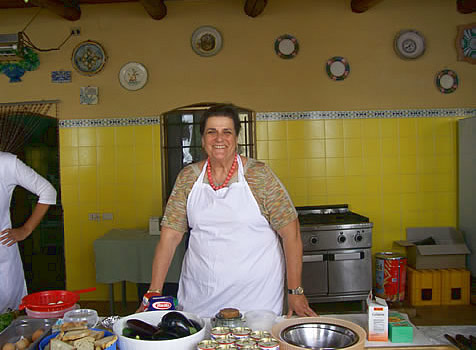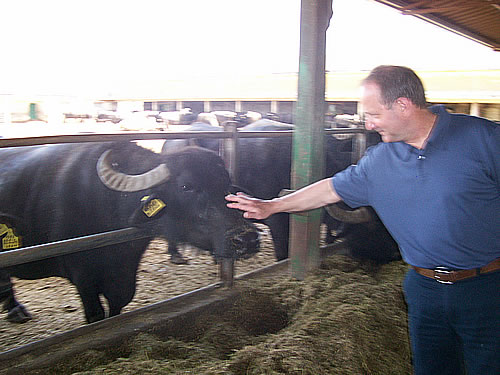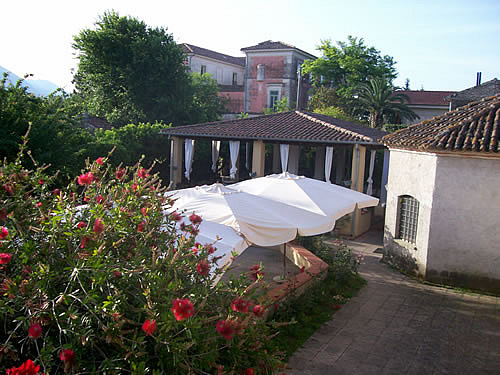An Agriturismo in Paestum, Italy
At Once Typical and Unique
Article and photos by Diana Saluri Russo

|
|
Cooking class at the Tenuta Seliano agriturismo in Southern Italy.
|
As it turns out, my husband’s enthusiasm for mozzarella di bufala (buffalo mozzarella) is what led us to branch out from other budget accommodations such as convents and monasteries in our most recent trip to Italy and give agriturismo a try.
Last May we were in Paestum to visit the Greek temples, among the best-preserved in the world, and decided to try Tenuta Seliano, an agriturismo in the heart of Campania’s mozzarella country and located 1.2 miles from the temples. As the former estate of a wealthy family, Tenuta Seliano, is a step up from many agriturismos — particularly those typically found in Southern Italy. You are more likely to find this kind of impressively restored estates in Tuscany or Umbria.
An agriturismo is a working farm or estate that also serves as a kind of B and B. Guests may stay in rooms, apartments or separate houses. Local products are often served at family-style meals.
Many offer tours of local sites, wine tastings, cooking classes covering local specialties, and horseback riding. They are largely less expensive than a typical hotel or pensione, and many offer swimming pools and gardens.
The owner, Cecilia Bellelli Baratta, converted her husband’s family estate to an agriturismo in 1991. It consists of a number of stone buildings — stables, barns, towers — that have been converted into rooms, cottages and dining rooms. The estate has been in her husband’s family since the 18th century.
The story of the Bellelli’s family’s fortunes is interestingly linked to the swampy geography of the area called the Piana del Sele where the ancient Greeks settled in the 6th century BC. The Greek and subsequently Roman settlement died out after deforestation of the nearby hills silted up the rivers, turning the area into a malarial swamp.
“It was a dangerous place to live,” says the baroness.
Until the 1960s the family moved to a nearby mountain village in the summer and returned to the estate only for short periods during the daytime. Land reclamation began in the 1930s under Mussolini, but was only completed in the 1960s.
The Belleli family maintains a herd of 900 Mediterranean water buffalo, 250 of which produce milk at any time. Only the milk-producing cows are given what Massimino calls the “spa treatment”, which means being allowed to wallow in a muddy pond.

|
|
Getting to know Seliano buffalo.
|
In a visit to a local mozzarella producer, Massimino explains that the cheese is made by a process of spinning and cutting and that the word “mozzarella” comes from the word “mossare” meaning “to chop.” The factory is small and typical of Italy, with about 10 workers who heat, stretch, cut, and shape the cheese. The finished product is milky and moist (never rubbery) when eaten fresh and made with non-pasteurized milk. After two days is the mozzarella is used for bruschetta or pizza. (The law requires that unused cheese is thrown away each day). Pasteurized mozzarella di bufala is sold throughout Italy, and has a shelf-life of 5-6 days.
“The cheese is very good because the milk is a raw milk — not pasteurized — and the cheese tastes just like what the cows actually eat. You taste that.” says the baroness.
Fresh mozzarella is the main feature at Seliano dinners served in the garden outside under an awning. The food is wonderful and there is plenty of time to get to know other travelers. Although agriturismos are considered budget option, this is not a backpacking crowd. Most of our fellow guests were well-heeled older travelers who were touring the Southern Italian coast by car. (One mentioned that the 75 euro he was paying at Seliano was 600 euro less than what he had spent on his last hotel in Positano.)
Rooms are inexpensive: 75 euro for a double (with a good breakfast included), but dinners are 20 euro. For budget travelers, who generally forego car rental, Seliano is easy to reach by train from Salerno (30 minutes ). Be prepared to pay 10 euro each way for taxis to the temples or the train station. If you can afford it, renting a car makes it possible to take daytrips along the stunning Amalfi Coast to visit Positano, Amalfi, Sorrento, and Salerno.
Although the grounds at Seliano are a wonderful mix of tropical vegetation and roses, the surrounding countryside is flat, barren and uninspiring , an eye opener for those who equate the Italian countryside with the ethereal beauty of Tuscany and Umbria.
I would recommend staying in either the tower or the cottages near the pool rather than the main house — mainly because the view of the courtyard with its lovely garden is best.

|
|
Agriturismo Seliano courtyard and grounds.
|
Diana Saluri Russo teaches journalism at Clarke College in Dubuque, IA and travels to Italy frequently.
|
